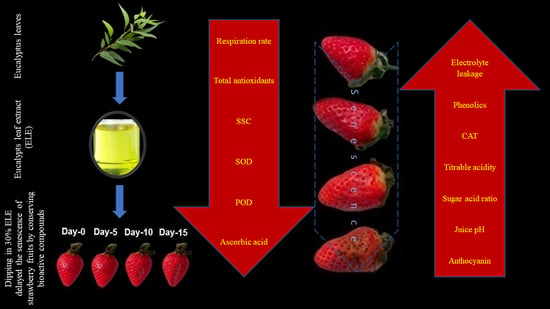Postharvest Eucalyptus Leaf Extract Application Extends the Sustainable Supply of Strawberries by Retaining Physicochemical Quality during Cold Storage
Abstract
1. Introduction
2. Materials and Methods
2.1. Fruit Source
2.2. Preparation of ELE Solution
2.3. Fruit Weight Loss, Fungal Decay Index, and Decayed Fruits
2.4. Respiration Rate and Electrolyte Leakage
2.5. Antioxidative Enzyme Activities
2.6. Biochemical Quality
2.7. General Appearance, Firmness, Flavor, and Marketable Fruits
2.8. Statistical Analysis
3. Results and Discussion
3.1. Fruit Weight Loss (%), Fungal Decay Index (Score), and Decayed Fruits (%)
3.2. Respiration Rate (CO2 mmol kg−1 h−1) and Electrolyte Leakage (%)
3.3. CAT, SOD, and POD Enzyme Activities (U mg−1 Protein)
3.4. SSC (%), TA (%), Sugar Acid Ratio, and Juice pH
3.5. Total Phenolic Contents (mg GAE kg−1), Ascorbic Acid (mg kg−1), Anthocyanins (ΔA g−1), and Total Antioxidants (DPPH Scavenging Activities)
3.6. General Appearance, Flavor, Firmness, and Marketable Fruits
4. Conclusions
Author Contributions
Funding
Institutional Review Board Statement
Informed Consent Statement
Data Availability Statement
Acknowledgments
Conflicts of Interest
References
- Akhtar, I.; Rab, A. Effect of irrigation intervals on the quality and storage performance of strawberry fruit. J. Anim. Plant Sci. 2015, 25, 669–678. [Google Scholar]
- Agriculture Statistics of Pakistan. Ministry of Food and Agriculture (Economic Wing); Government of Pakistan: Islamabad, Pakistan, 2015.
- Khan, M.N.; Sarwar, A.; Bhutto, S.; Wahab, M.F. Physicochemical characterization of the strawberry samples on regional basis using multivariate analysis. Int. J. Food Prop. 2010, 13, 789–799. [Google Scholar] [CrossRef]
- Atress, A.S.H.; El-Mogy, M.M.; Anean, H.E.A.; Alsannius, B.W. Improving strawberry fruit storability by edible coatings as a carrier of Thymol or calcium chloride. J. Hortic. Sci. Ornam. Plants 2010, 2, 88–97. [Google Scholar]
- Mahmood, M.A.; Sheikh, A.D. Citrus export system in Pakistan. J. Agric. Res. 2006, 44, 229–238. [Google Scholar]
- Nunes, M.C.N.; Morais, A.M.M.B.; Brecht, J.K.; Sargent, S.A. Fruit maturity and storage temperature influence response of strawberries to controlled atmospheres. J. Am. Soc. Hortic. Sci. 2002, 127, 836–842. [Google Scholar] [CrossRef]
- Maryam, A.; Anwar, R.; Malik, A.U.; Raheem, M.I.U.; Khan, A.S.; Hasan, M.U.; Hussain, Z.; Siddique, Z. Combined aqueous ozone and ultrasound application inhibits microbial spoilage, reduces pesticide residues and maintains storage quality of strawberry fruits. J. Food Meas. Charact. 2021, 15, 1437–1451. [Google Scholar] [CrossRef]
- Rico, D.; Martín-Diana, A.B.; Barat, J.M.; Barry-Ryan, C. Extending and measuring the quality of fresh-cut fruit and vegetables: A review. Trends Food Sci. Technol. 2007, 18, 373–386. [Google Scholar] [CrossRef]
- Hassanein, R.A.; Salem, E.A.; Zahran, A.A. Efficacy of coupling gamma irradiation with calcium chloride and lemon grass oil in maintaining guava fruit quality and inhibiting fungal growth during cold storage. Folia Hortic. 2020, 30, 67–78. [Google Scholar] [CrossRef]
- Servili, A.; Feliziani, E.; Romanazzi, G. Exposure to volatiles of essential oils alone or under hypobaric treatment to control postharvest gray mold of table grapes. Postharvest Biol. Technol. 2017, 133, 36–40. [Google Scholar] [CrossRef]
- Chen, C.; Cai, N.; Chen, J.; Peng, X.; Wan, C. Chitosan-Based coating enriched with hairy fig (Ficus hirta Vahl.) fruit extract for “Newhall” Navel Orange Preservation. Coatings 2018, 8, 445. [Google Scholar] [CrossRef]
- Hasan, M.U.; Malik, A.U.; Anwar, R.; Khan, A.S.; Haider, M.W.; Riaz, R.; Ali, S.; Rehman, R.N.U.; Ziaf, K. Postharvest Aloe vera gel coating application maintains the quality of harvested green chillies during cold storage. J. Food Biochem. 2021, 45, e13682. [Google Scholar] [CrossRef] [PubMed]
- Kahramanoğlu, I.; Aktaş, M.; Gündüz, Ş. Effects of fludioxonil, propolis and black seed oil application on the postharvest quality of “Wonderful” pomegranate. PLoS ONE 2018, 13, e0198411. [Google Scholar] [CrossRef] [PubMed]
- Zhang, C.; Long, Y.; Wang, Q.; Li, J.; Wu, X.; Li, M. The effect of preharvest 28.6% chitosan composite film sprays for controlling the soft rot on kiwifruit. Hortic. Sci. 2019, 46, 180–194. [Google Scholar] [CrossRef]
- Wahab, H.A.; Malek, A.; Ghobara, M. Effects of some plant extracts, bioagents, and organic compounds on Botrytis and Sclerotinia molds. Acta Agrobot. 2020, 73, 19–25. [Google Scholar] [CrossRef]
- Hassan, J.; Anwar, R.; Khan, A.S.; Ahmad, S.; Malik, A.U.; Nafees, M.; Hussain, Z.; Inam-ur-Raheem, M. Chitosan-based edible coating delays fungal decay and maintains quality of strawberries during storage. Int. J. Agric. Biol. 2020, 24, 486–492. [Google Scholar] [CrossRef]
- Kaur, S.; Gupta, S.; Gautam, B. Phytochemical analysis of Eucalyptus leaves extract. J. Pharmacogn. Phytochem. 2019, 8, 2442–2446. [Google Scholar]
- Abd-Elkader, D.Y.; Salem, M.Z.; Komeil, D.A.; Al-Huqail, A.A.; Ali, H.M.; Salah, A.H.; Akrami, M.; Hassan, H.S. Post-harvest enhancing and Botrytis cinerea control of strawberry fruits using low cost and eco-friendly natural oils. Agronomy 2021, 11, 1246. [Google Scholar] [CrossRef]
- Manzi, H.P.; Niyigena, V.; Matsiko, F.; Niyigaba, T.; Twagirayezu, G.; Irumva, O.; Nyiranshuti, A. Investigation of the effects of eucalyptus extracts on shelf-life of Passion fruit juice. Pol. J. Environ. Stud. 2022, 3, 2729–2736. [Google Scholar] [CrossRef]
- Vieira, A.M.F.D.; Steffens, C.A.; Argenta, L.C.; Amarante, C.V.T.D.; Oster, A.H.; Casa, R.T.; Amarante, A.G.M.; Espíndola, B.P. Essential oils for the postharvest control of blue mold and quality of ‘Fuji’ apples. Pesqui. Agropecu. Bras. 2018, 53, 547–556. [Google Scholar] [CrossRef]
- Xylia, P.; Chrysargyris, A.; Ahmed, Z.F.R.; Tzortzakis, N. Application of rosemary and eucalyptus essential oils and their main component on the preservation of apple and pear fruits. Horticulturae 2021, 7, 479. [Google Scholar] [CrossRef]
- Navarro, D.; Díaz-Mula, H.M.; Guillén, F.; Zapata, P.J.; Castillo, S.; Serrano, M.; Valero, D.; Martínez-Romero, D. Reduction of nectarine decay caused by Rhizopus stolonifer, Botrytis cinerea and Penicillium digitatum with Aloe vera gel alone or with the addition of thymol. Int. J. Food Microbiol. 2011, 151, 241–246. [Google Scholar] [CrossRef] [PubMed]
- Alemu, K.; Ayalew, A.; Woldetsadik, K. Antifungal activity of plant extracts and their applicability in extending the shelf-life of mango fruits. Food Sci. Qual. Manag. 2014, 33, 47–53. [Google Scholar]
- Khaliq, G.; Nisa, M.; Ramzan, M.; Koondhar, N. Textural properties and enzyme activity of mango (Mangifera indica L.) fruit coated with chitosan during storage. J. Agric. Stud. 2017, 5, 32–50. [Google Scholar] [CrossRef][Green Version]
- Vieira, J.M.; Flores-López, M.L.; de Rodríguez, D.J.; Sousa, M.C.; Vicente, A.A.; Martins, J.T. Effect of chitosan-Aloe vera coating on postharvest quality of blueberry (Vaccinium corymbosum) fruit. Postharvest Biol. Technol. 2016, 116, 88–97. [Google Scholar] [CrossRef]
- Ali, S.; Khan, A.S.; Anjum, M.A.; Nawaz, A.; Naz, S.; Ejaz, S.; Hussain, S. Aloe vera gel coating delays post-cut surface browning and maintains quality of cold stored lotus (Nelumbo nucifera Gaertn.) root slices. Sci. Hortic. 2019, 256, 108612. [Google Scholar] [CrossRef]
- Razzaq, K.; Khan, A.S.; Malik, A.U.; Shahid, M. Ripening period influences fruit softening and antioxidative system of ‘Samar Bahisht Chaunsa’ mango. Sci. Hortic. 2013, 160, 108–114. [Google Scholar] [CrossRef]
- Malik, A.U.; Hasan, M.U.; Hassan, W.U.; Khan, A.S.; Shah, M.S.; Rajwana, I.A.; Latif, M.; Anwar, R. Postharvest quarantine vapour heat treatment attenuates disease incidence, maintains eating quality and improves bioactive compounds of “Gola” and “Surahi” guava fruits. J. Food Meas. Charact. 2020, 15, 1666–1679. [Google Scholar] [CrossRef]
- Ainsworth, E.A.; Gillespie, K.M. Estimation of total phenolic contents and other oxidation substrates in plant tissue using Folin–Ciocalteu reagent. Nat. Protoc. 2007, 2, 875–877. [Google Scholar] [CrossRef]
- Ali, S.; Khan, A.S.; Malik, A.U.; Shahid, M. Effect of controlled atmosphere storage on pericarp browning, bioactive compounds and antioxidant enzymes of litchi fruits. Food Chem. 2016, 206, 18–29. [Google Scholar] [CrossRef]
- Kader, A.A.; Lipton, W.J.; Morris, L.L. Systems for scoring quality of harvested Lettuce. HortScience 1973, 8, 408–409. [Google Scholar] [CrossRef]
- Kelly, K.; Whitaker, V.M.; Nunes, M.C.N. Physicochemical characterization and postharvest performance of the new Sensation® ‘Florida127’ strawberry compared to commercial standards. Sci. Hortic. 2016, 211, 283–294. [Google Scholar] [CrossRef]
- Tyagi, K.A.; Bukvicki, D.; Gottardi, D.; Tabanelli, G.; Montanari, C.; Malik, A.; Guerzoni, M.E. Eucalyptus essential oil as a natural food preservative: In vivo and in vitro antiyeast potential. BioMed. Res. Int. 2014, 2014, 969143. [Google Scholar] [CrossRef] [PubMed]
- Ponce, A.G.; Fritz, R.; Del Valle, C.; Roura, S.I. Antimicrobial activity of essential oils on the native microflora of organic Swiss chard. LWT-Food Sci. Technol. 2003, 36, 679–684. [Google Scholar] [CrossRef]
- Castillo, S.; Navarro, D.; Zapata, P.J.; Guillén, F.; Valero, D.; Serrano, M.; Martínez-Romero, D. Antifungal efficacy of Aloe vera in-vitro and its use as a preharvest treatment to maintain postharvest table grape quality. Postharvest Biol. Technol. 2010, 57, 183–188. [Google Scholar] [CrossRef]
- González, L.A.; Torres, F.; Quiñones, W. Changes in Tomato Metabolism by Applying 1,8 Cineole. J. Microb. Biochem. Technol. 2015, 7, 323–326. [Google Scholar] [CrossRef]
- Vargas, M.; Albors, A.; Chiralt, A.; González-Martinez, C. Quality of cold stored strawberries as affected by chitosan-oleic acid edible coating. Postharvest Biol. Technol. 2006, 41, 164–171. [Google Scholar] [CrossRef]
- Lee, J.Y.; Park, H.J.; Lee, C.Y.; Choi, W.Y. Extending shelf-life of minimally processed apples with edible coatings and antibrowning agents. LWT-Food Sci. Technol. 2003, 36, 323–329. [Google Scholar] [CrossRef]
- Nourozi, F.; Sayyari, M. Enrichment of Aloe vera gel with basil seed mucilage preserve bioactive compounds and postharvest quality of apricot fruits. Sci. Hortic. 2020, 262, 109041. [Google Scholar] [CrossRef]
- Ozturk, B.; Karakaya, O.; Yıldız, K.; Saracoglu, O. Effects of Aloe vera gel and MAP on bioactive compounds and quality attributes of cherry laurel fruit during cold storage. Sci. Hortic. 2019, 249, 31–37. [Google Scholar] [CrossRef]
- Martínez-Romero, D.; Zapata, P.J.; Guillén, F.; Paladines, D.; Castillo, S.; Valero, D.; Serrano, M. The addition of rosehip oil to Aloe gels improves their properties as postharvest coatings for maintaining quality in plum. Food Chem. 2017, 217, 585–592. [Google Scholar] [CrossRef]
- Chauhan, O.P.; Nanjappa, C.; Ashok, N.; Ravi, N.; Roopa, N.; Raju, P.S. Shellac and Aloe vera gel based surface coating for shelf life extension of tomatoes. J. Food Sci. Technol. 2015, 52, 1200–1205. [Google Scholar] [CrossRef]
- Paladines, D.; Valero, D.; Valverde, J.M.; Mula, H.M.; Serrano, M.; Romero, D.M. The addition of rosehip oil improves the beneficial effect of Aloe vera gel on delaying ripening and maintaining postharvest quality of several stone fruit. Postharvest Biol. Technol. 2014, 92, 23–28. [Google Scholar] [CrossRef]
- Ratra, S.; Kaur, L.; Thukral, B. Effect of Aloe vera and wheat grass juice as an edible coating to prolong the shelf life of bananas. Int. J. Eng. Res. Technol. 2016, 3, 2648–2655. [Google Scholar]
- Li, T.; Shi, D.; Wu, Q.; Zhang, Z.; Qu, H.; Jiang, Y. Sodium para-aminosalicylate delays pericarp browning of litchi fruit by inhibiting ROS-mediated senescence during postharvest storage. Food Chem. 2019, 278, 552–559. [Google Scholar] [CrossRef] [PubMed]
- Hassanpour, H. Effect of Aloe vera gel coating on antioxidant capacity, antioxidant enzyme activities and decay in raspberry fruit. LWT-Food Sci. Technol. 2015, 60, 495–501. [Google Scholar] [CrossRef]
- Rasouli, M.; Saba, M.K.; Ramezanian, A. Inhibitory effect of salicylic acid and Aloe vera gel edible coating on microbial load and chilling injury of orange fruit. Sci. Hortic. 2019, 247, 27–34. [Google Scholar] [CrossRef]
- Badawy, M.E.I.; Rabea, E.I.; El-Nouby, M.; Ismail, R.I.A.; Taktak, N.E.M. Strawberry shelf life, composition, and enzymes activity in response to edible chitosan coatings. Int. J. Fruit Sci. 2016, 17, 117–136. [Google Scholar] [CrossRef]
- Mangena, T.; Muyima, N.Y.O. Comparative evaluation of the antimicrobial activities of essential oils of Artemisia afra, Pteronia incana and Rosemarinus officinalis on selected bacteria and yeast strains. Lett. Appl. Microbiol. 1999, 28, 291–296. [Google Scholar] [CrossRef] [PubMed]
- Tzortzakis, N.G. Maintaining postharvest quality of fresh produce with volatile compounds. Innov. Food Sci. Emerg. Technol. 2007, 8, 111–116. [Google Scholar] [CrossRef]
- Peyro, H.; Abbas, M.S.A.; Kavoosi, B. Effect of salicylic acid and Aloe vera gel on postharvest quality of table grapes (Vitis vinifera). Trakia J. Sci. 2017, 2, 154–159. [Google Scholar] [CrossRef]
- Wang, S.Y.; Gao, H. Effect of chitosan-based edible coating on antioxidants, antioxidant enzyme system, and postharvest fruit quality of strawberries (Fragaria × aranassa Duch.). LWT-Food Sci. Technol. 2013, 52, 71–79. [Google Scholar] [CrossRef]
- Liu, J.; Tian, S.; Meng, X.; Xu, Y. Effects of chitosan on control of postharvest diseases and physiological responses of tomato fruit. Postharvest Biol. Technol. 2007, 44, 300–306. [Google Scholar] [CrossRef]
- Badawy, M.E.; Rabea, E.I. Potential of the biopolymer chitosan with different molecular weights to control postharvest gray mold of tomato fruit. Postharvest Biol. Technol. 2009, 51, 110–117. [Google Scholar] [CrossRef]
- Khaliq, G.; Ramzan, M.; Baloch, A.H. Effect of Aloe vera gel coating enriched with Fagonia indica plant extract on physicochemical and antioxidant activity of sapodilla fruit during postharvest storage. Food Chem. 2019, 286, 346–353. [Google Scholar] [CrossRef] [PubMed]
- Youssef, K.; Roberto, S.R.; Tiepo, A.N.; Constantino, L.V.; Vilela de Resende, J.T.; Abo-Elyousr, K.A.M. Salt solution treatments trigger antioxidant defense response against gray mold disease in table grapes. J. Fungi 2020, 6, 179. [Google Scholar] [CrossRef]
- Falleh, H.; Jalleli, I.; Ksouri, R.; Boulaaba, M.; Guyot, S.; Magné, C.; Abdelly, C. Effect of salt treatment on phenolic compounds and antioxidant activity of two Mesembryanthemum edule provenances. Plant Physiol. Biochem. 2012, 52, 1–8. [Google Scholar] [CrossRef] [PubMed]
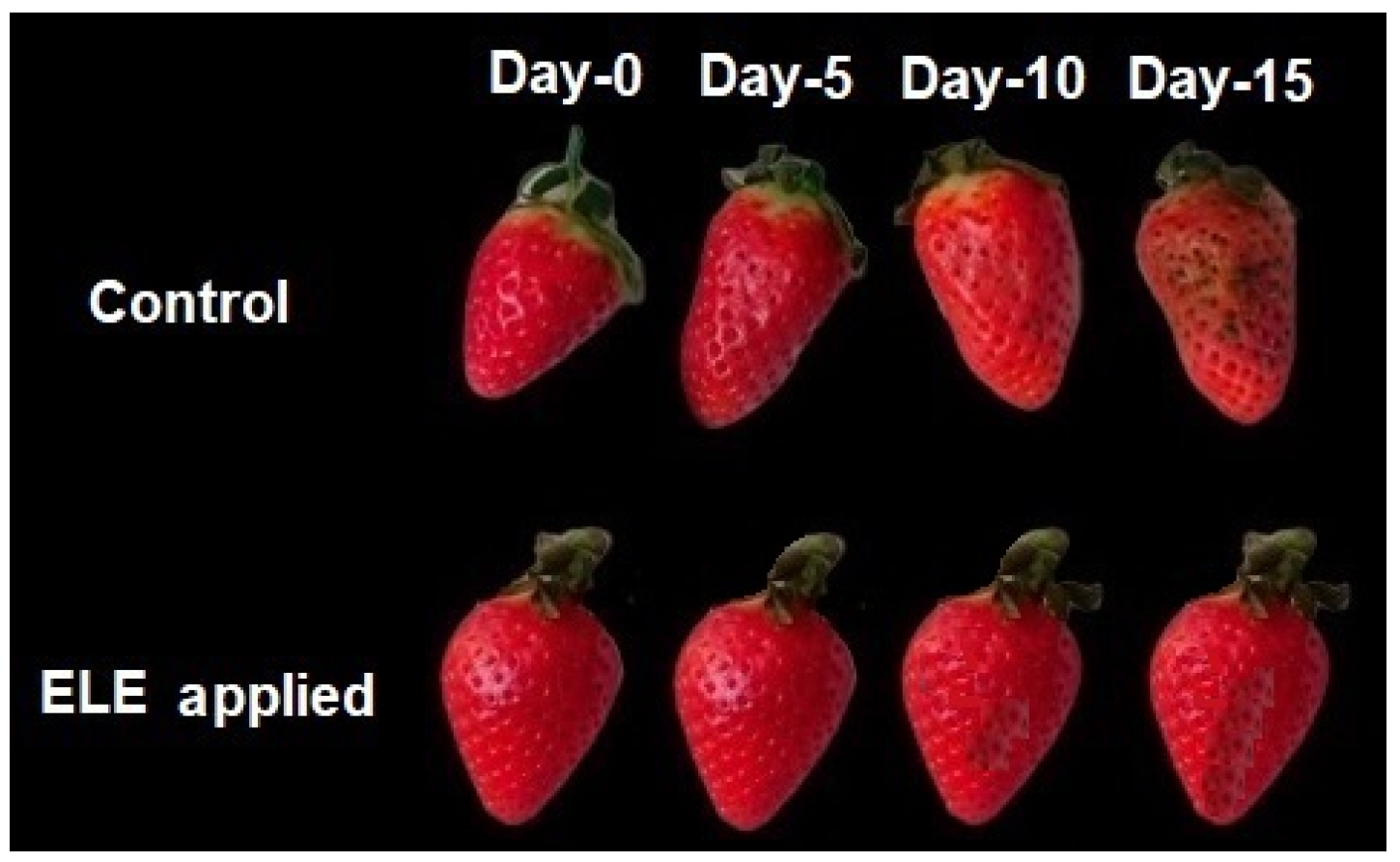

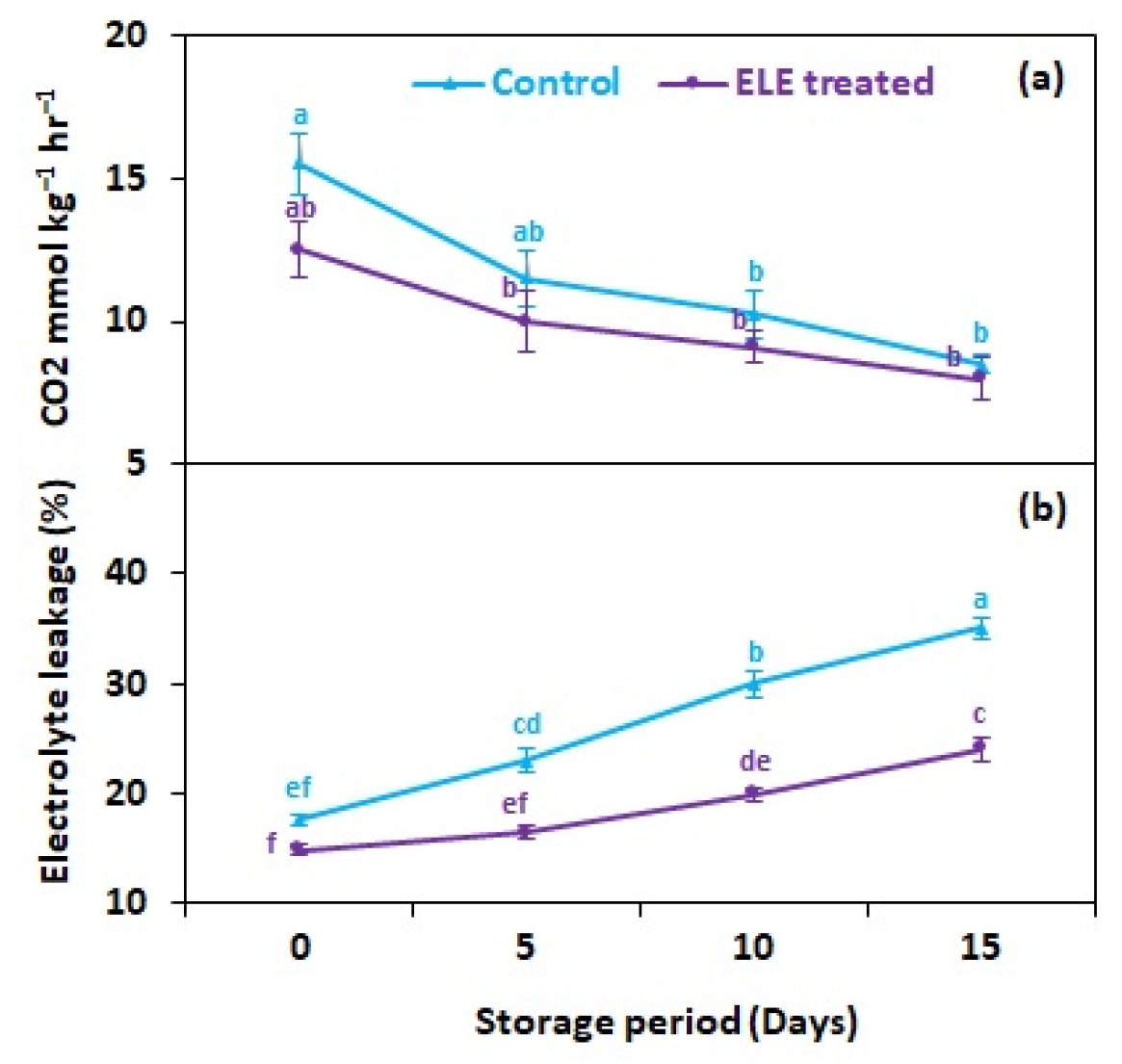
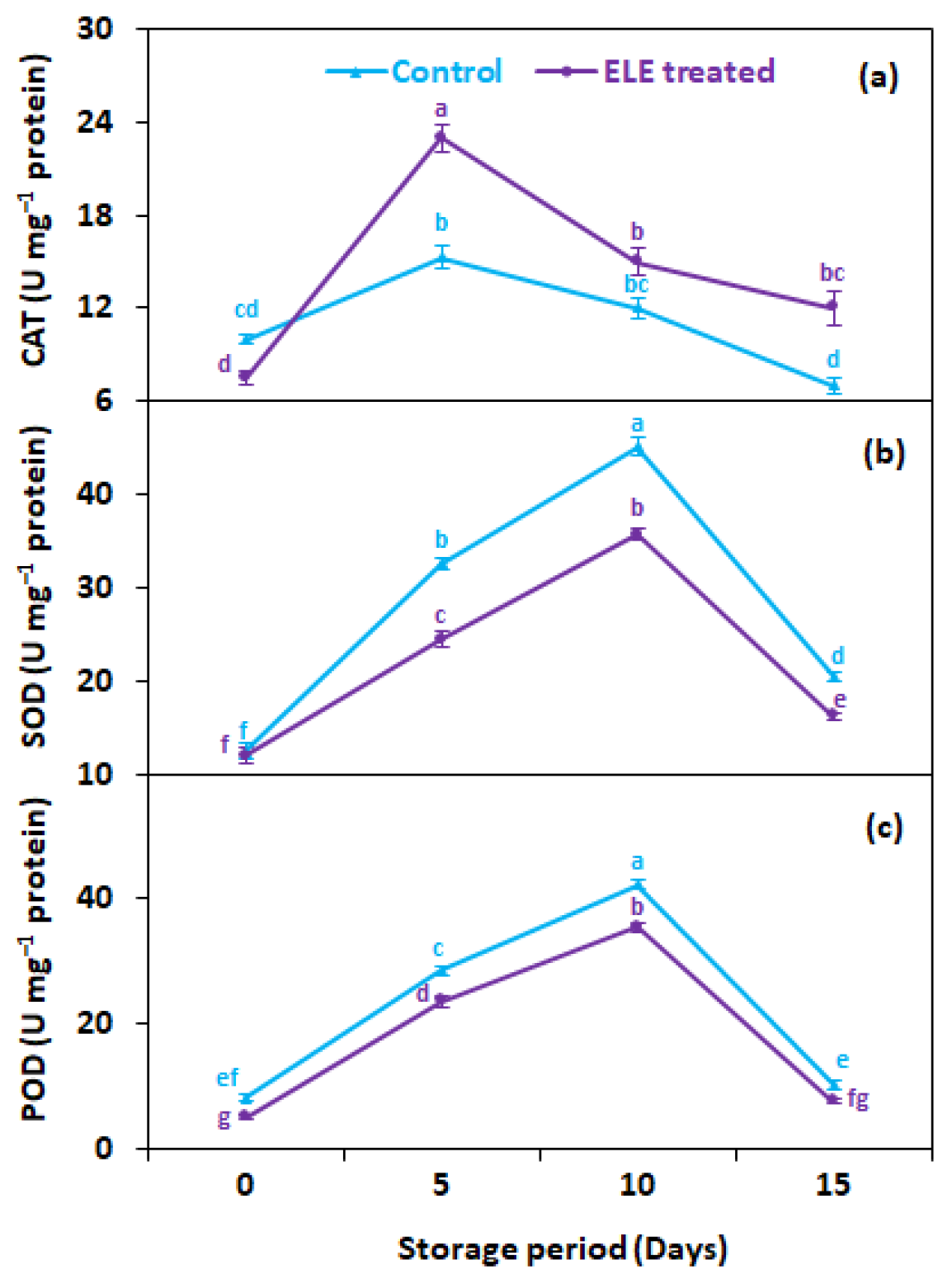
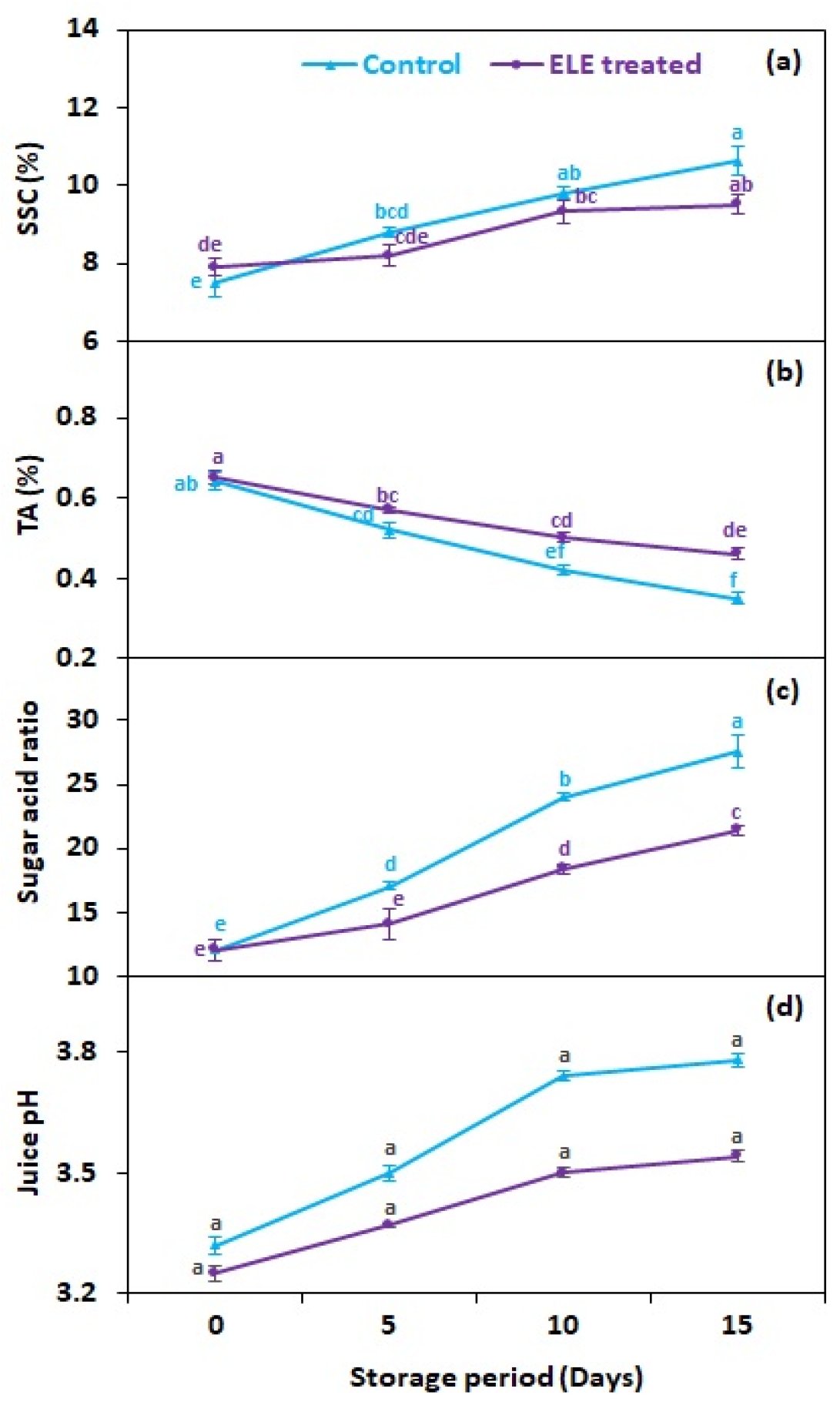


Publisher’s Note: MDPI stays neutral with regard to jurisdictional claims in published maps and institutional affiliations. |
© 2022 by the authors. Licensee MDPI, Basel, Switzerland. This article is an open access article distributed under the terms and conditions of the Creative Commons Attribution (CC BY) license (https://creativecommons.org/licenses/by/4.0/).
Share and Cite
Haider, M.W.; Nafees, M.; Valipour, M.; Iqbal, R.; Ali, S.; Asad, H.U.; Faried, H.N.; Aslam, M.; Iqbal, J.; Shahzad, M.A. Postharvest Eucalyptus Leaf Extract Application Extends the Sustainable Supply of Strawberries by Retaining Physicochemical Quality during Cold Storage. Sustainability 2022, 14, 14822. https://doi.org/10.3390/su142214822
Haider MW, Nafees M, Valipour M, Iqbal R, Ali S, Asad HU, Faried HN, Aslam M, Iqbal J, Shahzad MA. Postharvest Eucalyptus Leaf Extract Application Extends the Sustainable Supply of Strawberries by Retaining Physicochemical Quality during Cold Storage. Sustainability. 2022; 14(22):14822. https://doi.org/10.3390/su142214822
Chicago/Turabian StyleHaider, Muhammad Wasim, Muhammad Nafees, Mohammad Valipour, Rashid Iqbal, Sajid Ali, Habat Ullah Asad, Hafiz Nazar Faried, Muhammad Aslam, Javed Iqbal, and Muhammad Ayaz Shahzad. 2022. "Postharvest Eucalyptus Leaf Extract Application Extends the Sustainable Supply of Strawberries by Retaining Physicochemical Quality during Cold Storage" Sustainability 14, no. 22: 14822. https://doi.org/10.3390/su142214822
APA StyleHaider, M. W., Nafees, M., Valipour, M., Iqbal, R., Ali, S., Asad, H. U., Faried, H. N., Aslam, M., Iqbal, J., & Shahzad, M. A. (2022). Postharvest Eucalyptus Leaf Extract Application Extends the Sustainable Supply of Strawberries by Retaining Physicochemical Quality during Cold Storage. Sustainability, 14(22), 14822. https://doi.org/10.3390/su142214822






